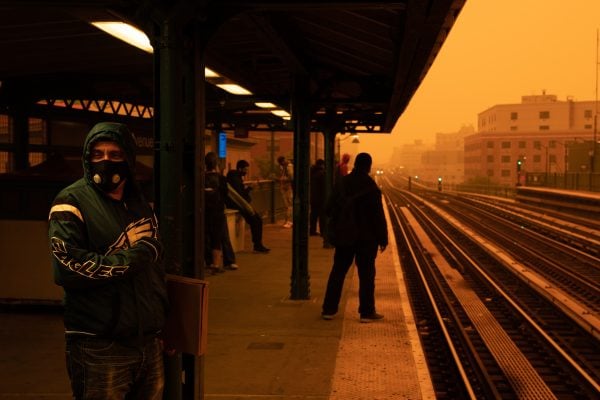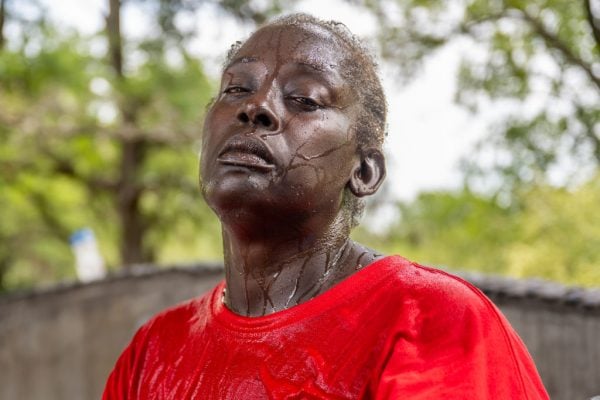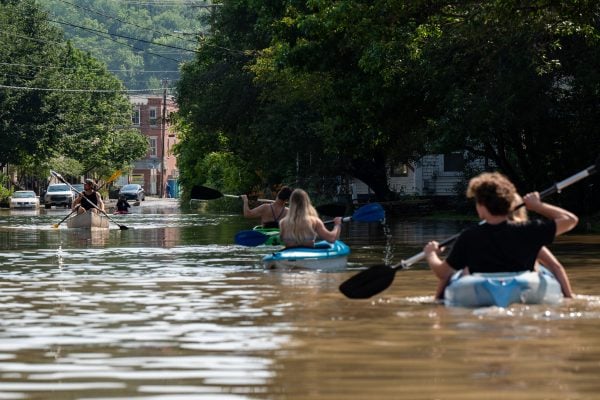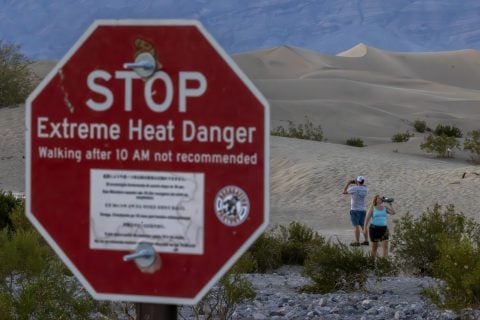Almost 68 million individuals within the U.S. have been dealing with excessive climate alerts as of Aug. 7 — that’s about one-fifth of the U.S. inhabitants. As a result of local weather change, extra individuals expertise hazardous climate situations like excessive warmth, wildfires, storms and floods, they usually expertise them extra usually. Some locations are extra susceptible to local weather change’s influence than others, however that doesn’t cease individuals from shifting to these spots.
A brand new evaluation by FinanceGrabber finds that almost all of the fastest-growing locations within the U.S. are additionally high-risk areas for pure hazards.
“Excessive warmth and humidity goes to be a actuality just about irrespective of the place you progress,” says Alex De Sherbinin, senior analysis scientist, deputy director and adjunct professor of local weather on the Columbia Local weather Faculty at Columbia College in New York. “However life-threatening damages from these sorts of issues are going to be extra restricted to some locales than others.”
You’re extra prone to expertise excessive climate proper now than at another time of yr. That’s as a result of the U.S. is in its “hazard season,” the interval between Could and October when North America experiences its worst local weather impacts, in accordance with the Union of Involved Scientists, a nonprofit advocacy group.
The summer season, thus far, has been brutal. June was the most popular month on document for the whole planet till July broke that document, in accordance with the Copernicus Local weather Change Service, a program organized and funded by the European Union, member states and associated companies.
Within the U.S., the South baked from oppressive warmth; the floor water temperature off the coast of Florida reached 101 levels Fahrenheit; and Demise Valley sweltered at 128 levels Fahrenheit — the most popular day on document. As well as, floods drowned components of New England, and Canada’s worst-ever wildfire season continues to be anticipated to choke the northern half of the united stateswith smoke periodically till the primary snowfall.
These are simply the instant results of our local weather emergency. Predicted long-term results embrace sea-level rise by as a lot as 10 to 12 inches within the 30-year interval between 2020 and 2050, the identical rise that was measured over a 100-year interval from 1920 to 2020, in accordance with a 2022 report by the Nationwide Oceanic and Atmospheric Administration.
Quick-growing locations are at excessive threat for worsening local weather situations
Among the many 10 fastest-growing counties, two are thought-about at very excessive threat for pure hazards and eight are thought-about at comparatively excessive threat for pure hazards. Not one of the fastest-growing counties are thought-about at comparatively average threat or low threat.

An individual ready for the subway wears a filtered masks as smoky haze from wildfires in Canada blankets a neighborhood on June 7 within the Bronx borough of New York Metropolis. (Picture by David Dee Delgado/Getty Photographs)
For context, of the three,231 counties the Federal Emergency Administration Company (FEMA) threat index covers, 15 are thought-about at very excessive threat (0.46%); 129 are thought-about at comparatively excessive threat (3.99%); and 397 are thought-about at comparatively average threat (12.29%).
The entire fastest-growing counties are situated within the western or southern components of the U.S., together with six counties in Texas, three in Florida and one in Arizona.
Every of the counties carries its personal potential hazards: hurricanes in all three counties in Florida; warmth waves in Maricopa County, Arizona; and a near-biblical assortment of dangers within the Texas counties, together with chilly waves, warmth waves, hurricanes, tornadoes, wildfires and extra.
There have been 4,762 federally declared disasters within the U.S. since 1953, in accordance with FEMA information. Every of the fastest-growing counties has had its fair proportion of federally declared disasters within the final 70 years. Hillsborough County, Florida, had probably the most occasions (39), adopted carefully by Lee County, Florida (37), and Montgomery County, Texas (36). In every of those counties, tropical storms have been the reason for the disasters.
Warming sea floor temperatures attributable to local weather change trigger hurricanes which are bigger, have extra intense wind speeds and higher precipitation, in accordance with the Middle for Local weather and Vitality Options, an environmental coverage suppose tank.

What occurs while you transfer to a high-risk space
Basically, shifting from one place to a different is closely age-dependent, says De Sherbinin. Youthful individuals are usually extra cell as they set up their careers, and have a tendency to cool down once they have a household. Older individuals migrate on the finish of their careers as a result of they wish to retire someplace close to household or have facilities they worth most.
“These classical motivations have been comparatively impervious to the sense that there’s a rising threat that we face as a society,” says De Sherbinin.
Prioritizing your life-style and profession preferences over avoiding excessive ecological dangers is solely human nature, says De Sherbinin. Why? Individuals don’t essentially suppose disaster will occur to them.
De Sherbinin says while you transfer to an space that’s extremely susceptible to local weather change results, the rationalization normally goes one thing like this: “‘I’m not going to be the one to lose my home over the cliff into the Pacific Ocean, as a result of I’m simply fortunate.’”
The U.S. tends to be an outlier in relation to individuals shifting into areas the place dangers are actually excessive, says De Sherbinin, who research the human elements of world environmental change. However the increased the danger of pure hazards, the extra susceptible the inhabitants is to direct and secondary impacts of climate occasions. Direct impacts are extra instant bodily hurt and property hurt, whereas secondary impacts are usually longer-term, corresponding to financial loss, social unrest and doubtlessly a retreat from the world.
As said earlier, local weather change is worsening the probability and the acute nature of climate occasions, which implies these excessive dangers could manifest in an actual means and extra usually.

Andrea Washington weeps after pouring water on herself within the Hungry Hill neighborhood on July 11 in Austin, Texas. Washington started to cry as she spoke concerning the warmth and her well being. (Picture by Brandon Bell/Getty Photographs)
For instance, the acute warmth situations in Texas not too long ago have been made considerably extra seemingly by local weather change, in accordance with the U.S. Local weather Shift Index (CSI) Map. Intense warmth in Houston, the county seat for Harris County — the second fastest-growing county in accordance with the Census Bureau — is now 5 instances extra widespread attributable to local weather change, in accordance with the CSI Map. With out local weather change, excessive warmth would in any other case be uncommon for that space, in accordance with the CSI scale.
About 80% of the U.S. inhabitants lives in cities the place “warmth island” results exacerbate excessive warmth situations. Among the many 44 main cities analyzed by Local weather Central, a nonprofit science and information group, 9 have greater than 1 million individuals who really feel not less than 8 levels Fahrenheit hotter as a result of city setting. Amongst these 9 cities, three are within the fastest-growing counties listed on this evaluation. Houston is on the record, in addition to Phoenix in Maricopa County, Arizona, and San Antonio in Bexar County, Texas.
Climate-battered locations could turn into uninsurable
Shifting to an space that’s at excessive threat for pure hazards could value you greater than you bargained for, in additional methods than one, starting with property insurance coverage.
Insurance coverage giants State Farm and Allstate not too long ago introduced that they’re now not issuing new house owner insurance policies in California. State Farm cites “quickly rising disaster publicity” amongst its causes for pulling again.
Loretta Worters, vp of media relations for the Insurance coverage Data Institute, says the trade is at a pivotal level as an entire. Insurers are growing methods to higher perceive the dangers of utmost climate occasions, however it’s getting harder to cost threat, she says. It additionally prices customers extra to get insurance coverage as a result of the dangers are so nice, Worters says.
“All people needs this idyllic form of life-style; we wish to be on the coast or we wish to be in these lovely, serene areas the place there’s numerous shrubbery and privateness,” says Worters. “However you’ll be able to’t get fireplace vans in — into areas which are susceptible to wildfires. Lots of these individuals’s properties are located such that it is laborious for the vans to rise up there as a result of they’re on winding roads.”
California isn’t the one state the place insurance coverage could also be laborious to return by attributable to persistent climate occasions. Flood-prone states have lengthy felt the sting of rising charges and problem getting protection. A not too long ago rolled-out change to the Nationwide Flood Insurance coverage Program (NFIP) is making it much more costly. This system is commonly the one one obtainable in flood-prone areas.
FEMA says the speed will increase, generally known as “Threat Ranking 2.0,” will allow the company to distribute premiums and set charges which are extra equitable than previously. The brand new methodology assesses extra variables than it used to love flood frequency, sorts of flooding, the property’s distance to a water supply in addition to its elevation, and prices to rebuild.
On June 1, a bunch of 10 states joined a go well with led by Louisiana Lawyer Gen. Jeff Landry in opposition to FEMA, the Division of Homeland Safety and the Federal Insurance coverage and Mitigation Administration in an try to dam steep fee will increase to the NFIP that went totally into impact on April 1. The states — which embrace Florida, Idaho, Kentucky, Louisiana, Mississippi, Montana, North Dakota, South Carolina, Texas and Virginia — argue the upper charges may drive policyholders to drop their protection or find yourself surrendering their properties and companies.
Insurance coverage prices have climbed in the previous couple of a long time: Insured disaster losses have elevated by almost 700% for the reason that Eighties when adjusted for inflation, in accordance with the Insurance coverage Data Institute. And in 2021, insured losses from pure catastrophes totaled $130 billion — 76% increased than the Twenty first-century common.
If extra insurers pull out of areas attributable to persistent climate situations like wildfires and hurricanes, areas may turn into astronomically costly to insure, if not altogether uninsurable. Fewer personal insurers obtainable means owners will seemingly want to show to Honest Entry to Insurance coverage Necessities (FAIR) plans. All states have some sort of a plan, which is instituted on the state degree and backed by personal insurers licensed to put in writing insurance coverage within the state. The entire corporations have a proportionate share in any earnings, losses and bills of the plans.
FAIR plans normally provide solely fundamental protection and are used “as a final resort,” in accordance with the Nationwide Affiliation of Insurance coverage Commissioners (NAIC), a nonprofit regulatory assist group.
Worters, of the Insurance coverage Data Institute, says FAIR plans are prone to have increased deductibles and fewer protection, they usually could also be harder to acquire. Nonetheless, they’re broadly used: 10% of Florida owners have insurance coverage via the state’s FAIR plan, the Residents Property Insurance coverage Corp., as of March 2022, in accordance with the NAIC.

Individuals kayak up and down the flooded waters of Elm Road on July 11 in Montpelier, Vermont. (Picture by Kylie Cooper/Getty Photographs)
Rising charges are a supply of hysteria and frustration for policyholders, says Worters, however she provides that the insurance coverage trade isn’t the one occasion that should reply to worsening local weather situations. Property dangers will be mitigated, she says, via coverage and property safeguards corresponding to constructing codes in hurricane-prone areas or defensible house necessities — buffers round property — in wildfire-prone areas.
“We’re insuring it, however in the event you proceed to dwell in these areas and also you don’t take any measures to safeguard your property or your online business, it simply makes issues worse.”
Stephanie Pincetl, founding director and professor on the California Middle for Sustainable Communities at UCLA, says altering how we dwell will probably be essential to combating the impacts of local weather change. “I believe that we have to understand the American sample of land use contributes 100% in the direction of local weather change and in addition has heaps and many different ramifications. And we’ve not been coping with that,” says Pincetl. “We now have massive homes, we’ve many loos, we’ve personal gardens and so forth. And people are inherently energy-intensive, land-intensive and water-intensive.”
Will individuals migrate attributable to local weather change?
If local weather situations worsen in your space, you’ll inevitably be confronted with this conundrum: Ought to I keep, or ought to I’m going?
The reply to that query will largely depend upon in the event you’re responding to an ongoing local weather situation otherwise you’re pressured to reply to an occasion, says Andrew Jakabovics, vp for coverage growth at Enterprise Group Companions and co-author of “Housing Markets and Local weather Migration,” by the City Institute, an financial and social coverage suppose tank.
The Council on Overseas Relations (CFR), an unbiased suppose tank, says local weather change-fueled disasters are rising migration worldwide. CFR finds most migration happens inside nationwide borders, however cross-border migration is anticipated to rise. On the finish of 2022, 8.7 million individuals worldwide — 675,000 within the U.S. alone — have been dwelling in inside displacement attributable to weather-related disasters, in accordance with the Inside Displacement Monitoring Centre (IDMC). From 2008 to 2022, 11.1 million individuals have been displaced within the U.S. attributable to weather-related disasters, the IDMC discovered.
Chronically worsening situations — annual wildfires, hurricanes, warmth waves and floods — could not essentially destroy your property, however they’re actually going to influence your life. Specialists say excessive climate occasions are those that make it harder to face your floor.
“We’re not well-evolved when it comes to our reasoning to form of bear in mind low-probability however very high-impact occasions,” says De Sherbinin. “We will react when one thing huge occurs and determine, ‘Oh, God, that was actually means an excessive amount of,’ however we’re not well-evolved to deal with issues which are form of regularly altering over time.”

A lady drinks amongst sand dunes close to an indication warning of utmost warmth hazard on the eve of a day that might set a brand new world warmth document in Demise Valley Nationwide Park on July 15 close to Furnace Creek, California. (Picture by David McNew/Getty Photographs)
And for individuals who already dwell in high-risk areas, their single largest funding is their house, says De Sherbinin. They usually’re not going to go away simply “as a result of flood threat has risen from one in 100 years to at least one in 10 years,” he says. “They simply roll the cube and determine that out later. Or they’ll foyer to get their authorities to construct the mandatory infrastructure to guard them.”
When individuals do go away, they hardly ever go far. The Dialog, a nonprofit information group largely written by teachers and researchers, mapped out the place individuals transfer following flooding disasters via FEMA’s Hazard Mitigation Grant Program from 1990 to 2017. It’s a buyout program that pays owners to buy and demolish flood-damaged properties. The information exhibits that irrespective of the place the flooding occurred, most owners who took a buyout stayed shut by — simply 7.4 miles was the median distance. Three in 4 individuals stayed inside 20 miles of their unique properties.
Amongst those that do go away, usually familial ties and communal ties drive relocation decisions, says Jakabovics. “In case you’re leaving the island of Puerto Rico, there was a form of a preexisting inhabitants in components of Florida. That was under no circumstances the one geography that folks moved to, however there was a focus there,” says Jakabovics.
There are additionally individuals who, even within the occasion of a catastrophe, wish to return to their properties as a result of, understandably, it’s their house. At that time, habitability turns into a query of security compliance, insurance coverage and extra. In case you’re not a home-owner and also you wish to return, it’s possible you’ll face a fair larger problem.
“In case you’re a renter, proper, you have got little or no management over the bodily state of the property. And so, it is determined by what the owner has to or can do,” says Jakabovics. “We all know that post-Hurricane Katrina, a number of the rental inventory was uninhabitable and a number of the new insurance coverage necessities and issues like that made it very, very tough to maintain these properties liveable.”
In fact, the longer you wait to go away a high-risk space, the tougher it is perhaps. “As a substitute of a form of orderly, considerate course of, which Individuals have a really laborious time with, individuals will probably be dropping their shirts,” says Pincetl.“They will not be capable of promote their properties.”
Is anyplace actually protected to dwell?
Nowhere is totally protected to dwell, however some areas will probably be much less susceptible to sure disasters than others. Warmth is most excessive within the southern states, and particularly in probably the most arid areas; flooding is worse alongside the coasts and close to massive our bodies of water; and tornadoes are extra widespread within the Nice Plains. The San Andreas fault stretches alongside the whole California coast, whereas different, smaller fault strains are unfold all through the west. The best-threat volcanoes sit alongside the West Coast of the continental U.S., in addition to Alaska and Hawaii. No place is immune.
Whether or not you’ll be able to go someplace “safer” will rely in your monetary scenario. For tens of millions of Individuals who dwell in poverty, the extra related query is prone to be, “Can I afford to go?”
Populations which are extra usually affected by and fewer capable of stand up to the well being impacts of local weather change embrace older adults, youngsters, low-income communities and a few communities of shade, in accordance with a 2018 authorities report generally known as the “Fourth Nationwide Local weather Evaluation.”
Leaving one space for one more will all the time be simpler for these with the monetary sources to take action. When excessive climate or a pure catastrophe hits, these with higher socioeconomic challenges have much less capacity to go away. They usually’ll additionally bear the brunt of worsening climate situations to return.
FinanceGrabber drew the record of fastest-growing counties utilizing 2021-2022 information from the U.S. Census Bureau, the latest obtainable information set. The fastest-growing counties on this record have been restricted to the highest 10. The fastest-growing counties are these with the very best numeric inhabitants will increase over a set interval. The ten counties have been then matched with their corresponding dangers utilizing the Federal Emergency Administration Company National Risk Index and FEMA’s historical data for catastrophe declarations from 1953 onward.
(Lead photograph by Mario Tama/Getty Photographs Information through Getty Picture)










